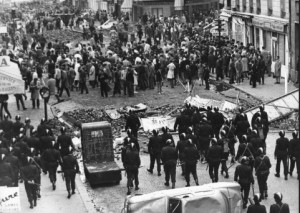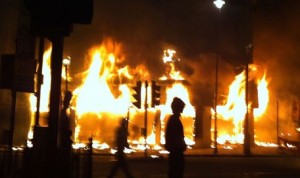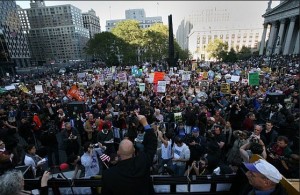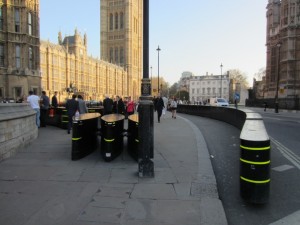OC 49: Openness through Cooperation
Openness: a construct of social relations
Openness of cities can be understood literally as spaces and places open to all. At a theoretical level, urban thinkers are construing openness of cities as the outcome of social relations which, in turn, are influenced by the dynamic of urban change. These notions were conceptualised around May ’68, for example in terms of ‘The Right to the City’ [Henri Lefebvre. 1971. Le droit a la ville I. Editions anthropos. Henri Lefebvre. 1972. Espace et politique, le droit a la ville II. Editions anthropos] or ‘The Urban Question’, [Manuel Castells. 1972. La question urbaine. Maspero]. Both concepts can be understood to symbolise ‘open cities’.

1_dia May 68, not quite a revolution, source: source: http://internationalist-perspective.org/IP/ip-archive/ip_49_may-68.html
Inertia and immediacy
Cities have evolved since then in physical-environmental as well as socio-political and economic terms, reflecting social relations and practices past and present within the dominant system of liberal capitalism. The latest global economic crisis is manifesting its effects in and on the city through inertia of material change and immediacy of human responses to changing urban circumstances shown on the media and over social networks.

2_dia TV picture of the riots: viral violence, source: http://www.guardian.co.uk/media/2012/mar/28/uk-riots-twitter-facebook
The violence manifested at riots in London and elsewhere in 2011 is raising fear which, in turn, is enabling the forces of law and order to intervene in the public realm and restrict its openness. This applies to the physical fabric of the city as well as its digital connectedness. The report published on 27 March 2012 by the “Riots, Communities and Victims Panel” set up by the government concludes that riots were made worse by rolling news and social networks. It notes that innovations in mobile communications technology could benefit police to detect crowds and to use cell congestion monitoring as a tool to tackle rioting. Meanwhile, barriers are going up continuously to protect public buildings and politicians. They are a visual expression of how cities are adapting to increasing confrontation and adversarial behaviour, legitimising domination of existing powers and reinforcing spatial and social segregation. It could be argued that this top down hierarchical chain of command process is impairing city openness.
Barriers between the rulers and the ruled
In the view of a left leaning political think tank – Compass – these restrictive impositions hamper cooperation between politicians and citizens, the state and local communities, factions defending diverging interests. At their annual lecture on 26 March Richard Sennett elaborated on the craft of collaboration, based on his latest book [Together, the rituals, pleasures and politics of cooperation, 2012, Allen Lane, Penguin Books]. A link could be drawn between openness and cooperation, arguing that city openness is sustained by bottom up cooperative modes of living in common. ‘Occupy’ is but one example of an attempt to reinvent inclusive, self-organising cooperation between unknowns, a more equitable democratic modus vivendi for cosmopolitan urban society.

4_dia Occupy Wall Street source: http://warincontext.org/2011/10/05/occupy-wall-street-gaining-traction/
On his blog, http://pmarcuse.wordpress.com/2012/03/25/11-blog-11-reforms-radical-reformstransformative-claims/ Peter Marcuse reflects on the nature of reforming society along a cumulative taxonomy, ranging from efficiency reforms to liberal and radical reforms, and cumulating in transformative claims. He explores the various stages of such reforms against the evolution of Occupy Wall Street, concluding that the conditions for transformative change do not exist, but that all reforms should include a transformative component to be truly innovative.
Sennett’s take on Occupy Wall Street is somewhat different as he focuses on cooperation as a promising mode of social action which is expected to engage people as an expression of human interdependence and which mobilises cooperation with the ‘unknown other’ subjected to active morality.
He conceives cooperation as a conscious effort which requires three types of skills: ‘dialogics’ as opposed to dialectics, listening skill to understand intentions and meanings when relating to strangers; subjunctive speech instead of declarative speech, leaving space for exchange and ambiguity, and language demanding similar looseness to leave room for interpretation. Finally cooperation requires empathy, not sympathy which is emotional and subjective and identifies with the other, but a cooler empathy based on curiosity for the other while leaving a distance filled by respect for difference.
Unlearning routines
A debate on these concepts with experiences intercepted by a politician and activists involved with cooperatives and community action groups, and real life contributions of a self selected audience could not agree on the relation between the political and the social left. Perhaps unlearning routine arguments was more important than establishing a balance between abstract notions of polity and society for those who are seeking an alternative construct to put into the place of the dominant model of competitive capitalism where satisfaction comes from personal engagement with the ‘unknown other’ and active citizenship rather than from material possessions, status, money and power.

6_ children’s cooperation source: http://www.guardian.co.uk/books/2012/feb/03/together-politics-cooperation-richard-sennett-review


